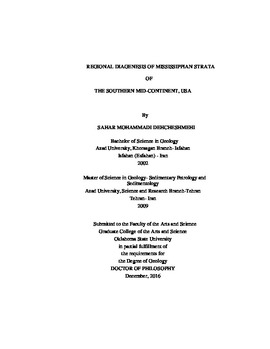| dc.contributor.advisor | Gregg, Jay M. | |
| dc.contributor.author | Mohammadi Dehcheshmehi, Sahar | |
| dc.date.accessioned | 2018-03-13T18:16:08Z | |
| dc.date.available | 2018-03-13T18:16:08Z | |
| dc.date.issued | 2016-12 | |
| dc.identifier.uri | https://hdl.handle.net/11244/54573 | |
| dc.description.abstract | Mississippian carbonates are one of the most complex and largest resource plays on the southern Midcontinent. This study involves petrographic, geochemical, and fluid inclusion analysis of fracture, breccia, vug, and inter- and intragrain porosity filling dolomite, calcite, and authigenic quartz cements on Mississippian carbonates from the Cherokee-Ozark platform area of Northern Oklahoma, SE Kansas, SW Missouri, and NW Arkansas to north-central Oklahoma. Open space filling calcite, quartz, and dolomite cements were observed in Mississippian rocks throughout the study area. These include early and late calcite cements and saddle dolomite cements precipitated by seawater, mixed meteoric and seawater, and late (burial) diagenetic fluids. Carbon and oxygen isotope values for calcite, dolomite, and quartz cements in the whole studied region are consistent with three types of diagenetic fluids: seawater; seawater modified by meteoric water; and evolved basinal water. Low d13C values of some of the calcite and dolomite cements indicate diagenesis under conditions of microbial sulfate reduction, in the case of early cements or thermochemical sulfate reduction associated with later petroleum migration. Analysis of fluid inclusions in late calcite, dolomite, and quartz cements in the study area indicates the presence of both dilute and high salinity end-member fluids (salinities range from 0 to 25 equivalent weight % NaCl). Homogenization temperatures (Th) of fluid inclusions range from 50 to 175C. The salinities and temperatures of these included fluids are consistent with a saline basinal fluid variably displacing and mixing with a dilute fluid of meteoric or mixed seawater/meteoric origin. Petroleum inclusions were observed in the late diagenetic calcite and dolomite cements indicating that precipitation of these cements was concurrent with petroleum migration. Calculated equilibrium d18Owater values (VSMOW) for fluids that precipitated open space filling calcite and dolomite cements are variable in study area as a whole, and do not reflect a single end-member water. There is more overlap in calculated d18Owater values for carbonate cement and host carbonate in most areas of north-central Oklahoma than in the Cherokee-Ozark platform area. This could represent mixing between resident and non-resident fluids, dominated by resident fluids in equilibrium with the host limestone. | |
| dc.format | application/pdf | |
| dc.language | en_US | |
| dc.rights | Copyright is held by the author who has granted the Oklahoma State University Library the non-exclusive right to share this material in its institutional repository. Contact Digital Library Services at lib-dls@okstate.edu or 405-744-9161 for the permission policy on the use, reproduction or distribution of this material. | |
| dc.title | Regional diagenesis of Mississippian strata of the southern mid-continent, USA | |
| dc.contributor.committeeMember | Grammer, Michael G. | |
| dc.contributor.committeeMember | Puckette, James O. | |
| dc.contributor.committeeMember | Shelton, Kevin L. | |
| dc.contributor.committeeMember | White, Jeffery L. | |
| osu.filename | MohammadiDehcheshmehi_okstate_0664D_14872.pdf | |
| osu.accesstype | Open Access | |
| dc.type.genre | Dissertation | |
| dc.type.material | Text | |
| thesis.degree.discipline | Geology | |
| thesis.degree.grantor | Oklahoma State University | |
